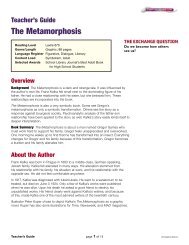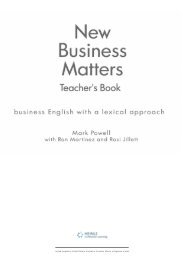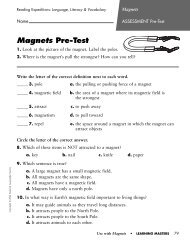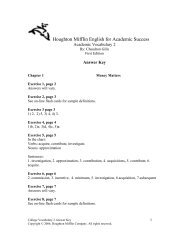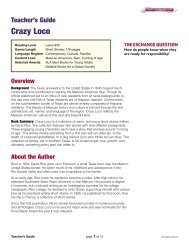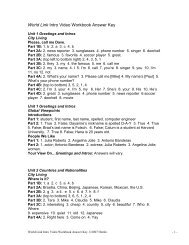English for Cabin Crew Trainer's Guide - Heinle
English for Cabin Crew Trainer's Guide - Heinle
English for Cabin Crew Trainer's Guide - Heinle
You also want an ePaper? Increase the reach of your titles
YUMPU automatically turns print PDFs into web optimized ePapers that Google loves.
UNIT<br />
8 Complaints and disruptive passengers<br />
LEAD IN Speaking<br />
Write the following phrases on the board: threw a punch; had a<br />
food fi ght; lit a cigarette; screamed abuse; grabbed my uni<strong>for</strong>m;<br />
vandalized the seat; tampered with emergency equipment.<br />
Ask students what the words mean and whether they have<br />
experienced any of these situations. Elicit stories of disruptive<br />
behaviour and other phrases that could be used to describe them.<br />
Managing disruptive passengers<br />
EXERCISE 1 Speaking<br />
Give students time to read the situation and questions. Ask them to<br />
discuss the questions in pairs. Get feedback in open class.<br />
Pre-teaching vocabulary<br />
Check knock over (push to the ground) and restrain (hold back).<br />
EXERCISE 2 Listening<br />
Give students time to read the situation and the questions. Ask students<br />
to have a guess as to what the situation might be. Play the recording.<br />
Students listen, note answers and then check in pairs. Get feedback in<br />
open class.<br />
Answers<br />
1 He’s drunk and shouting.<br />
2 another drink/vodka<br />
3 very aggressive, verbally and physically<br />
4 get his own drink<br />
5 They restrain him by strapping his wrist to the arm-rest.<br />
6 speak to the captain<br />
7 to have the police meet the aircraft<br />
8 reassure them that the situation is under control<br />
EXERCISE 3 Reading<br />
Ask students to read the report and try to work out what words are<br />
missing. Let them discuss their answers in pairs. Read out the report<br />
with the missing words included so that students can hear and check<br />
their answers.<br />
Answers<br />
1 landing 2 aggressive 3 alcohol 4 shout 5 several 6 control<br />
7 strapped 8 purser 9 calm 10 police<br />
Vocabulary in context<br />
Write the following defi nitions on the board and ask students to match<br />
them to words in the text: shout in a high pitched voice (scream); told<br />
about the situation (in<strong>for</strong>med); <strong>for</strong>mally taken by the police (arrested).<br />
35<br />
EXPRESSING OBLIGATION Language focus<br />
Give students time to read through the phrases in the box. Alternatively,<br />
read out the phrases and ask students to read and follow. Ask, What <strong>for</strong>m<br />
of the verb do we use after must, have to and need to? (infi nitive).<br />
Language notes<br />
Essentially, these verbs expressing obligation are interchangeable and<br />
can be taught in this context as having the same meaning. However, in<br />
fact, they do have small variations in meaning. Compare the following:<br />
In the UK, you have to drive on the left. (expresses an obligation imposed<br />
from outside – a law or regulation, <strong>for</strong> example)<br />
I must phone my mum. She’ll be worried. (expresses a personal obligation<br />
imposed upon you by yourself)<br />
I need to water the plants or they’ll die. (expresses a necessity)<br />
So, if the fl ight attendant says I have to speak to the captain, she means<br />
that she has no choice as it is the procedure or regulation. But, if she<br />
says I must speak to the captain, she’s implying that the obligation to do<br />
this is imposed by herself alone.<br />
Have to and need to behave like regular verbs (Do you have to ...? Do you<br />
need to ...?). Must is a modal verb. I’ve got to ... is a more in<strong>for</strong>mal way<br />
of saying I have to.<br />
EXERCISE 4 Pronunciation<br />
Play the recording. Ask students to listen and note the pronunciation of<br />
have to. Play the recording again. Ask students to listen and repeat.<br />
Pronunciation notes<br />
Have to is pronounced /'h&vt@/ in continuous speech.<br />
EXERCISE 5 Pronunciation<br />
Play the recording. Ask students to listen and repeat the phrases. You<br />
could ask students to work in pairs to practise saying the phrases in a<br />
reassuring tone of voice.<br />
ROUND UP<br />
If your students enjoy acting, you could ask them to work<br />
in groups of three to prepare a role play involving a fl ight<br />
attendant, a disruptive passenger and an upset passenger. Give<br />
them fi ve minutes to prepare what they are going to say, then<br />
ask a few groups to act out their role play in open class.<br />
Alternatively, ask students to prepare to talk about a real<br />
situation they experienced. Write the following prompts on the<br />
board and give students time to prepare be<strong>for</strong>e telling their story<br />
to the class or their group: What happened? What did you do?<br />
What did you say? What happened in the end?



